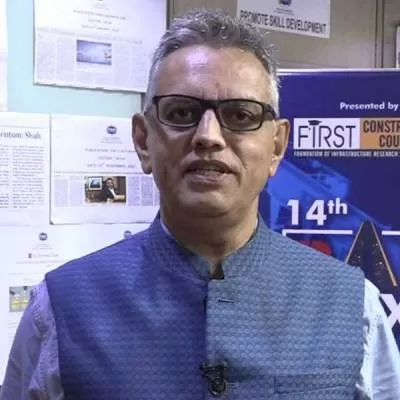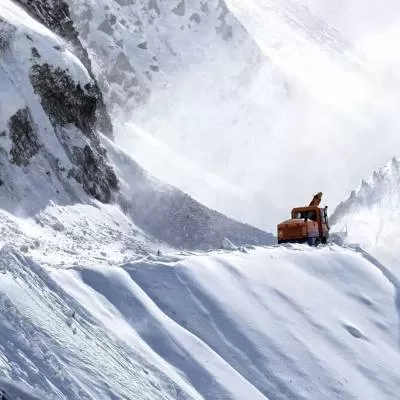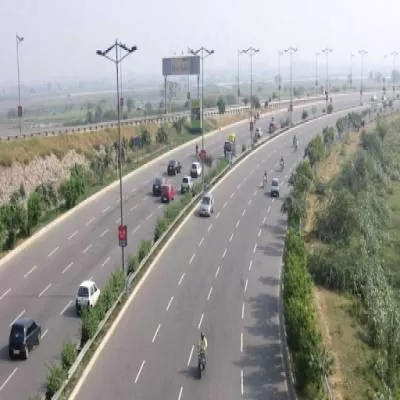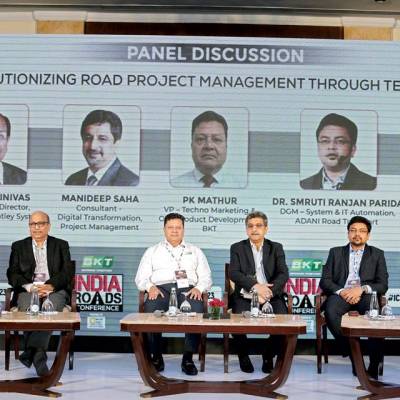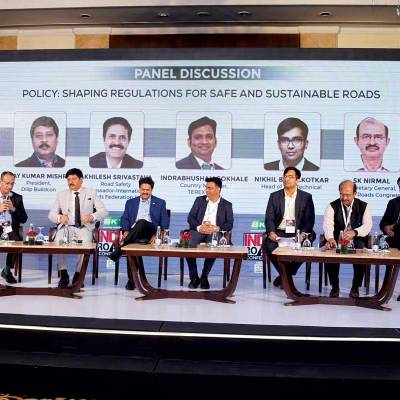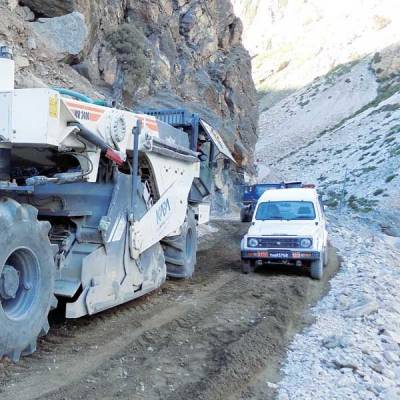- Home
- Infrastructure Transport
- ROADS & HIGHWAYS
- A Smooth Ride
A Smooth Ride
You may have heard this: The government is pushing to build 20 km of roads every day to improve India's infrastructure and further our economic success story. To this end, it has announced plans of investing Rs 550 billion ($10.47 billion) in highway construction projects this year (FY12-13) alone.
Nevertheless, demand is not uniform across segments of the gamut of equipment used for road construction. Ramesh Palagiri, Managing Director & CEO, Wirtgen India Pvt Ltd, estimates that the market for equipment used purely for constructing roads, such as pavers and rollers, has been expanding at a moderate 15 per cent compared to 20-25 per cent growth for the earthmoving and concreting segments (which are used in road construction as well as other areas) primarily because nine out of every 10 road projects are facing a time overrun owing to land acquisition problems. "Road projects can be fast-tracked only when a solution is found to land acquisition," he observes.
Discerning buyers
Being in the grip of time overruns in the face of rising input costs is making road-developing companies more conscious about ways to enhance productivity. Buying cost-effective equipment and optimising its usage are top of the list of a growing number of players. As a result, it is becoming common to conduct detailed market studies to compare similar equipment from different vendors.
According to Shankar N Srivastava, Director, Engineer Pro Consultants, "Market surveys should take into account the range of equipment required for a particular activity. Vendors supplying the complete range of such equipment are preferable as complementary equipment capacities add to the value chain. For instance, buying a sensor paver, a tandem roller (TR) and a pneumatic tire roller (PTR) from one manufacturer (such as Atlas Copco Dynapac or Wirtgen's Vogele/Hamm) makes sense as the vendor would match the capacities of these pieces of equipment that are used in series. Dealing with a sole supplier also improves and simplifies after-sales service. On the same lines, investing in a Caterpillar dumper, loader and excavator would enhance the efficiency of earthmoving operations."
Better vendor evaluation
In addition, buyers must study the equipment specifications to ensure that they meet the job requirements. "Look for productivity-enhancing features," suggests Srivastava. Companies with pan-India operations should review the reach of the vendor's after-sales support in different parts of the country, because as he points out, "the location of the equipment will continue to change with every new project." Warranty coverage should preferably be single-window coverage for all the aggregates from different manufacturers fitted on the same equipment. Last, the buyer must examine the total ownership cost, not only the acquisition price.
Srivastava cites Mckinsey, BMI, IDFC, KPMG and IBEF as a few reputed agencies that provide a lot of information on the construction equipment industry. But buyers have to collate the data and put together the total picture to be able to take informed decisions, or use a consultant/ advisor to do the same for them.
Single-window solutions
As far as possible, single-window solutions are gaining ground because of the multitude of economies they offer. Providers aware of this trend are entering into alliances with world-class brands to offer end-to-end solutions.
Somnath Bhattacharjee, President of TIL's Material Handling Solutions and Equipment & Project Solutions Business, says, "New business associations are allowing us to expand our product portfolio and offer superior and multiple solutions for a wider cross-section of application segments and customers. The Equipment & Project Solutions vertical of TIL focuses on providing 'single-window' solutions in crushing and screening and offering innovative eco-friendly asphalt mix technology for road construction in association with ASTEC Inc of the US."
According to GVR Murthy, Joint Managing Director, TIPL, the wholly owned subsidiary of TIL, "Our Cat product range encompassing a wide gamut of construction equipment – excavators, compacters, backhoe loaders, dozers, motor graders – serves customers across India. The bundling of solutions includes not only the entire product range, but rental solutions, maintenance contracts, extended life programmes and expert service contracts pioneered by us, wherein the availability and cost of machine maintenance is assured, sometimes even by our keeping stand-by machines to meet any eventualities."
Investing in technology
Increasing market studies are testament to the willingness of road construction companies to invest in new technology, and not necessarily buy the cheapest equipment. In part, this is also accountable to a renewed focus on quality and, therefore, a commitment to use technology that ensures the best outcomes, that is, the smoothest rides.
Most leading equipment vendors, across segments of machinery needed for road construction, are focused on innovating to improve equipment performance. For instance, Wirtgen pavers are the preferred choice of many leading road developers. According to Palagiri, "Vogele's path-breaking technologies like electric heating and high compaction screed, egroplus operating concept and its continuous emphasis on innovations to improve levels and outcomes is what makes the pavers stand out."
Demand for crushing and screening plants is estimated to be around 390 this year. Nawa Engineers, a leading vendor of screening and crushing plants, is preparing for this upsurge by upgrading the technology driving all 47 of its models of equipment and introducing equipment ranges where it lacks a product. Citing an example of the technology upgrade, V Subhash Babu, CEO, Nawa Engi-neers & Consultants (P) Ltd, says, "Duracode SRM series, Nawa's high capacity cone crusher in both standalone and mobile formats, has been made more user-friendly." He explains that it is cheaper to run as it consumes less power and is easier to maintain as now all major maintenance can be done from above or outside the crusher. Low friction in the drives prevents the shaft from spinning when the crusher is running empty, or is lightly fed with segregated feed, thus eliminating the need for a shaft brake. Few parts mean less maintenance and cost savings. The drive design permits crusher speed changes that empower the operator and reduce wear and tear on the gear drive. "The market will also see a SRM300 (300 tph) cone crusher to cater to the emerging demand," he adds. "NAWA is also bullish on its VSI crushers for manufactured sand, which is the machine of choice in Maharashtra, as more states are expected to announce a ban on sand mining this year. Andhra Pradesh has already banned the use of mined river sand."
Best practices
Road construction companies are not only adopting best practices relating to equipment procurement but growing wise to ways to optimise equipment usage and minimise losses in case of machinery breakdown.
According to Sanjay Londhe, CEO, Projects, Ashoka Buildcon Ltd, "Developers and contractors buying equipment for road projects must make sure the equipment bank is located near the construction site. Having adequate spare parts for the equipment and stand-by machinery that can be immediately mobilised in case of a breakdown helps avoid losses on account of mechanical breakdowns. Investing in one's own bank reduces dependency on third parties."
"The scarcity of trained manpower is one of the biggest challenges facing the construction industry," says BV Raisinghani, President, Jaiprakash Associates Ltd. "Not only developers and contractors, equipment vendors too are affected by this scarcity. It translates into a shortage of skilled after-sales service technicians with sharp fault-finding skills. In addition to entering into annual maintenance contracts, developers/contractors would do well to get their own staff trained in these techniques."
Going forward, the perfect choice of equipment, loaded with value-adding features, backed by best usage practices, will undoubtedly ensure that road constructing companies maximise their investments in technology.
Case Study 1
Project: Underpass at Dwarka, Delhi
Essential equipment: The set of construction equipment used included a 75 tonne crawler crane and a vibratory hammer to install the sheet piles to retain the support structure, excavators for top to bottom excavation to create the underpass, a 400 tonne truck-mounted crane to launch the pre-cast girders, and boom placers for the concreting process.
Choice of equipment: According to Vidhushekhar, Manager-Purchase, Valecha Engineering Ltd, "We opted for a Putzmeister boom placer and an ICE vibratory hammer, which are our own. The 75 tonne crawler crane was a hired TFC 280. Equipment should not only be hired for its price but for the condition of the machinery based on a thorough inspection and the specifications as well. In this case, we also reviewed the working area available and the load-bearing chart to determine the right crane. As it was a short job, it was more cost-effective to hire the cranes."
Case Study 2
Project: 456 km of roads constructed in hilly terrain by B Seenaiah & Company (BSC) and C&C Constructions (C&C) JV in Afghanistan
Essential equipment: Contractors executing road making or widening projects in hilly regions must negotiate narrow roads, steep gradients and sharp curves. According to Ashok Kumar, Chief General Manager, BSC and C&C JV, "This needs a narrower paver, roller set and machineries of high manoeuvrability. Usually, a paver of 3.5 m width having facility for extension to 5.5 m, and a set of rollers, combination of 1 m width and 2.5 m, are preferred as these can match the pavement width. Powerful and lightweight pavers and rollers that can be easily transported to work site are a must. Also, long arm excavators and a concrete boom placer are useful in hilly areas. Incidentally, narrow pavers and rollers are also useful in road widening projects in flat areas where the existing traffic cannot be stopped and the pavement width is limited."
Choice of equipment: Wirtgen pavers, IR rollers and Caterpillar or L&T Komatsu long arm excavators, all preferred for their features, maintenance and durability.
Case Study 3
Project: Negotiating curves in highway projects being executed by Ashoka Buildcon
Essential equipment: Curves are an integral part of highways, more challenging to negotiate in hilly or rocky terrains. High power graders and ultra modern pavers fitted with highly efficient sensors are essential to construct high quality and safe curves.
Choice of equipment: "We prefer to use Wirtgen slip form pavers for rigid pavements and Vogele or Dynapac pavers for flexible pavements," says Sanjay Londhe, CEO, Projects, Ashoka Buildcon Ltd. But he cautions that the role of the surveyor who lays down the 'string line' to guide these high-end pavers is very important. These pavers are preferred for their in-built sensors that help ensure that the paver steers and levels accurately. New Bki Ski multiplex sensor technology includes three sensors working in a row. This can be used to average and scan road irregularities to achieve better smoothness and riding quality. Also, the equipment should be versatile and capable of working on a rugged terrain. It must consume fuel reasonably to ensure working economies.
Case Study 4
Project: Yamuna Expressway by Jaypee Group
Essential equipment: Concrete batching plants and screening and crushing plants are essential for big highway projects. Owning this equipment helps improve bottom lines and ensure the quality of the outcome as the developer/contractor has complete control over the production of the inputs, even if road segments are subcontracted as is usually the case.
Choice of equipment: "We conducted a study of after-sales services offered by various providers and came to the conclusion that Schwing Stetter batching plants are the best choice. We use Metso, Puzzolana or Nawa crushing and screening plants," says BV Raisinghani, President, Jaiprakash Associates Ltd.
Case Study 5
Project: Construction of the foundation of the pillars of the Bandra-Worli Sea Link (BWSL) by HCC Ltd
Essential equipment: Crawler cranes are used for piling, grabbing, material handling applications and heavy lifts. Ten units of FUWA QUY 80 m crawler cranes were used for grabbing application to remove material during the well sinking operation.
Choice of equipment: FUWA crawler cranes were technically well suited for this application as this model is equipped with two drums, both of which have a free fall arrangement. This makes the FUWA crane versatile and capable of lifting and grabbing. In spite of being imported cranes, FUWA India, ie,. Fushun Cranes and Equipment India Pvt Ltd's 36 service engineers, 32 support staff and spares inventory worth over $1.5 million, back the use of 450 units in India.
Sanjay Vasudeo and Nitin Madankar, Directors of FUWA Cranes, say, "The growth in infrastructure development, power, port, road, rail, metro, and various sea link projects will generate huge potential for crawler cranes in India. Supreme Infra is also using FUWA crawler cranes mounted on a barge for a bridge project at Bhiwandi, near Mumbai. FUWA crawler cranes also find application in the construction of bridges over rivers and have been used in many such projects."
Share your views or experiences with Road Equipment and write in at feedback@ASAPPmedia.com
Challenges in executing highway contracts, rising input costs and growing awareness of quality are making road construction companies more discerning about their choice of equipment, in a bid to enhance outcomes and minimise equipment downtime, discovers Charu Bahri.You may have heard this: The government is pushing to build 20 km of roads every day to improve India's infrastructure and further our economic success story. To this end, it has announced plans of investing Rs 550 billion ($10.47 billion) in highway construction projects this year (FY12-13) alone.Nevertheless, demand is not uniform across segments of the gamut of equipment used for road construction. Ramesh Palagiri, Managing Director & CEO, Wirtgen India Pvt Ltd, estimates that the market for equipment used purely for constructing roads, such as pavers and rollers, has been expanding at a moderate 15 per cent compared to 20-25 per cent growth for the earthmoving and concreting segments (which are used in road construction as well as other areas) primarily because nine out of every 10 road projects are facing a time overrun owing to land acquisition problems. Road projects can be fast-tracked only when a solution is found to land acquisition, he observes.Discerning buyersBeing in the grip of time overruns in the face of rising input costs is making road-developing companies more conscious about ways to enhance productivity. Buying cost-effective equipment and optimising its usage are top of the list of a growing number of players. As a result, it is becoming common to conduct detailed market studies to compare similar equipment from different vendors.According to Shankar N Srivastava, Director, Engineer Pro Consultants, Market surveys should take into account the range of equipment required for a particular activity. Vendors supplying the complete range of such equipment are preferable as complementary equipment capacities add to the value chain. For instance, buying a sensor paver, a tandem roller (TR) and a pneumatic tire roller (PTR) from one manufacturer (such as Atlas Copco Dynapac or Wirtgen's Vogele/Hamm) makes sense as the vendor would match the capacities of these pieces of equipment that are used in series. Dealing with a sole supplier also improves and simplifies after-sales service. On the same lines, investing in a Caterpillar dumper, loader and excavator would enhance the efficiency of earthmoving operations.Better vendor evaluationIn addition, buyers must study the equipment specifications to ensure that they meet the job requirements. Look for productivity-enhancing features, suggests Srivastava. Companies with pan-India operations should review the reach of the vendor's after-sales support in different parts of the country, because as he points out, the location of the equipment will continue to change with every new project. Warranty coverage should preferably be single-window coverage for all the aggregates from different manufacturers fitted on the same equipment. Last, the buyer must examine the total ownership cost, not only the acquisition price.Srivastava cites Mckinsey, BMI, IDFC, KPMG and IBEF as a few reputed agencies that provide a lot of information on the construction equipment industry. But buyers have to collate the data and put together the total picture to be able to take informed decisions, or use a consultant/ advisor to do the same for them.Single-window solutionsAs far as possible, single-window solutions are gaining ground because of the multitude of economies they offer. Providers aware of this trend are entering into alliances with world-class brands to offer end-to-end solutions.Somnath Bhattacharjee, President of TIL's Material Handling Solutions and Equipment & Project Solutions Business, says, New business associations are allowing us to expand our product portfolio and offer superior and multiple solutions for a wider cross-section of application segments and customers. The Equipment & Project Solutions vertical of TIL focuses on providing 'single-window' solutions in crushing and screening and offering innovative eco-friendly asphalt mix technology for road construction in association with ASTEC Inc of the US.According to GVR Murthy, Joint Managing Director, TIPL, the wholly owned subsidiary of TIL, Our Cat product range encompassing a wide gamut of construction equipment – excavators, compacters, backhoe loaders, dozers, motor graders – serves customers across India. The bundling of solutions includes not only the entire product range, but rental solutions, maintenance contracts, extended life programmes and expert service contracts pioneered by us, wherein the availability and cost of machine maintenance is assured, sometimes even by our keeping stand-by machines to meet any eventualities.Investing in technologyIncreasing market studies are testament to the willingness of road construction companies to invest in new technology, and not necessarily buy the cheapest equipment. In part, this is also accountable to a renewed focus on quality and, therefore, a commitment to use technology that ensures the best outcomes, that is, the smoothest rides.Most leading equipment vendors, across segments of machinery needed for road construction, are focused on innovating to improve equipment performance. For instance, Wirtgen pavers are the preferred choice of many leading road developers. According to Palagiri, Vogele's path-breaking technologies like electric heating and high compaction screed, egroplus operating concept and its continuous emphasis on innovations to improve levels and outcomes is what makes the pavers stand out.Demand for crushing and screening plants is estimated to be around 390 this year. Nawa Engineers, a leading vendor of screening and crushing plants, is preparing for this upsurge by upgrading the technology driving all 47 of its models of equipment and introducing equipment ranges where it lacks a product. Citing an example of the technology upgrade, V Subhash Babu, CEO, Nawa Engi-neers & Consultants (P) Ltd, says, Duracode SRM series, Nawa's high capacity cone crusher in both standalone and mobile formats, has been made more user-friendly. He explains that it is cheaper to run as it consumes less power and is easier to maintain as now all major maintenance can be done from above or outside the crusher. Low friction in the drives prevents the shaft from spinning when the crusher is running empty, or is lightly fed with segregated feed, thus eliminating the need for a shaft brake. Few parts mean less maintenance and cost savings. The drive design permits crusher speed changes that empower the operator and reduce wear and tear on the gear drive. The market will also see a SRM300 (300 tph) cone crusher to cater to the emerging demand, he adds. NAWA is also bullish on its VSI crushers for manufactured sand, which is the machine of choice in Maharashtra, as more states are expected to announce a ban on sand mining this year. Andhra Pradesh has already banned the use of mined river sand.Best practicesRoad construction companies are not only adopting best practices relating to equipment procurement but growing wise to ways to optimise equipment usage and minimise losses in case of machinery breakdown.According to Sanjay Londhe, CEO, Projects, Ashoka Buildcon Ltd, Developers and contractors buying equipment for road projects must make sure the equipment bank is located near the construction site. Having adequate spare parts for the equipment and stand-by machinery that can be immediately mobilised in case of a breakdown helps avoid losses on account of mechanical breakdowns. Investing in one's own bank reduces dependency on third parties.The scarcity of trained manpower is one of the biggest challenges facing the construction industry, says BV Raisinghani, President, Jaiprakash Associates Ltd. Not only developers and contractors, equipment vendors too are affected by this scarcity. It translates into a shortage of skilled after-sales service technicians with sharp fault-finding skills. In addition to entering into annual maintenance contracts, developers/contractors would do well to get their own staff trained in these techniques.Going forward, the perfect choice of equipment, loaded with value-adding features, backed by best usage practices, will undoubtedly ensure that road constructing companies maximise their investments in technology.Case Study 1Project: Underpass at Dwarka, DelhiEssential equipment: The set of construction equipment used included a 75 tonne crawler crane and a vibratory hammer to install the sheet piles to retain the support structure, excavators for top to bottom excavation to create the underpass, a 400 tonne truck-mounted crane to launch the pre-cast girders, and boom placers for the concreting process.Choice of equipment: According to Vidhushekhar, Manager-Purchase, Valecha Engineering Ltd, We opted for a Putzmeister boom placer and an ICE vibratory hammer, which are our own. The 75 tonne crawler crane was a hired TFC 280. Equipment should not only be hired for its price but for the condition of the machinery based on a thorough inspection and the specifications as well. In this case, we also reviewed the working area available and the load-bearing chart to determine the right crane. As it was a short job, it was more cost-effective to hire the cranes.Case Study 2Project: 456 km of roads constructed in hilly terrain by B Seenaiah & Company (BSC) and C&C Constructions (C&C) JV in AfghanistanEssential equipment: Contractors executing road making or widening projects in hilly regions must negotiate narrow roads, steep gradients and sharp curves. According to Ashok Kumar, Chief General Manager, BSC and C&C JV, This needs a narrower paver, roller set and machineries of high manoeuvrability. Usually, a paver of 3.5 m width having facility for extension to 5.5 m, and a set of rollers, combination of 1 m width and 2.5 m, are preferred as these can match the pavement width. Powerful and lightweight pavers and rollers that can be easily transported to work site are a must. Also, long arm excavators and a concrete boom placer are useful in hilly areas. Incidentally, narrow pavers and rollers are also useful in road widening projects in flat areas where the existing traffic cannot be stopped and the pavement width is limited.Choice of equipment: Wirtgen pavers, IR rollers and Caterpillar or L&T Komatsu long arm excavators, all preferred for their features, maintenance and durability.Case Study 3Project: Negotiating curves in highway projects being executed by Ashoka BuildconEssential equipment: Curves are an integral part of highways, more challenging to negotiate in hilly or rocky terrains. High power graders and ultra modern pavers fitted with highly efficient sensors are essential to construct high quality and safe curves.Choice of equipment: We prefer to use Wirtgen slip form pavers for rigid pavements and Vogele or Dynapac pavers for flexible pavements, says Sanjay Londhe, CEO, Projects, Ashoka Buildcon Ltd. But he cautions that the role of the surveyor who lays down the 'string line' to guide these high-end pavers is very important. These pavers are preferred for their in-built sensors that help ensure that the paver steers and levels accurately. New Bki Ski multiplex sensor technology includes three sensors working in a row. This can be used to average and scan road irregularities to achieve better smoothness and riding quality. Also, the equipment should be versatile and capable of working on a rugged terrain. It must consume fuel reasonably to ensure working economies.Case Study 4Project: Yamuna Expressway by Jaypee GroupEssential equipment: Concrete batching plants and screening and crushing plants are essential for big highway projects. Owning this equipment helps improve bottom lines and ensure the quality of the outcome as the developer/contractor has complete control over the production of the inputs, even if road segments are subcontracted as is usually the case.Choice of equipment: We conducted a study of after-sales services offered by various providers and came to the conclusion that Schwing Stetter batching plants are the best choice. We use Metso, Puzzolana or Nawa crushing and screening plants, says BV Raisinghani, President, Jaiprakash Associates Ltd.Case Study 5Project: Construction of the foundation of the pillars of the Bandra-Worli Sea Link (BWSL) by HCC LtdEssential equipment: Crawler cranes are used for piling, grabbing, material handling applications and heavy lifts. Ten units of FUWA QUY 80 m crawler cranes were used for grabbing application to remove material during the well sinking operation. Choice of equipment: FUWA crawler cranes were technically well suited for this application as this model is equipped with two drums, both of which have a free fall arrangement. This makes the FUWA crane versatile and capable of lifting and grabbing. In spite of being imported cranes, FUWA India, ie,. Fushun Cranes and Equipment India Pvt Ltd's 36 service engineers, 32 support staff and spares inventory worth over $1.5 million, back the use of 450 units in India.Sanjay Vasudeo and Nitin Madankar, Directors of FUWA Cranes, say, The growth in infrastructure development, power, port, road, rail, metro, and various sea link projects will generate huge potential for crawler cranes in India. Supreme Infra is also using FUWA crawler cranes mounted on a barge for a bridge project at Bhiwandi, near Mumbai. FUWA crawler cranes also find application in the construction of bridges over rivers and have been used in many such projects.Share your views or experiences with Road Equipment and write in at feedback@ASAPPmedia.com




